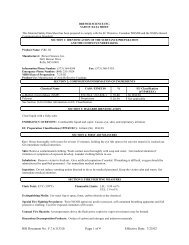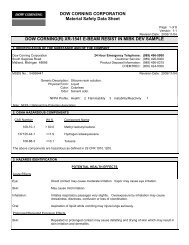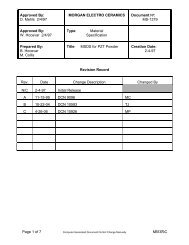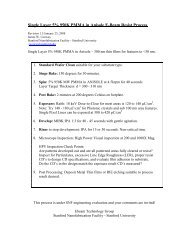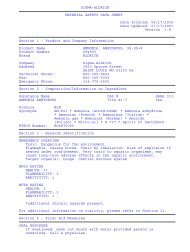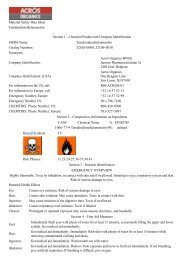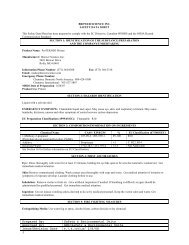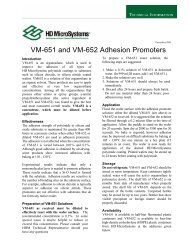MSDS M10 - Stanford Nanofabrication Facility
MSDS M10 - Stanford Nanofabrication Facility
MSDS M10 - Stanford Nanofabrication Facility
Create successful ePaper yourself
Turn your PDF publications into a flip-book with our unique Google optimized e-Paper software.
1. PRODUCT AND COMPANY IDENTIFICATION<br />
MATERIAL SAFETY DATA SHEET - NO. <strong>M10</strong><br />
Beryllium Solid SYNONYMS:<br />
Metallic Beryllium Glucinium<br />
I220H IF-1<br />
S200F S200FH<br />
S200FC SR200<br />
S65 PS200<br />
PF10 PF60<br />
O-30 I-70<br />
UHP Beryllium I-70H<br />
.9999 Beryllium B-26D<br />
Be<br />
24-HR. EMERGENCY ASSISTANCE CHEMICAL FAMILY Beryllium<br />
Transportation Emergency<br />
Call Chemtrec at: CUSTOMER SERVICE<br />
Domestic: (800) 424-9300 Brush Wellman Inc.<br />
International: (703) 527-3887 Product Stewardship Department<br />
Other Emergency 6070 Parkland Boulevard<br />
Call Brush Wellman at: (800) 862-4118 Mayfield Heights, Ohio 44124<br />
Phone: (800) 862-4118 or (216) 486-4200<br />
Revised: 01-01-10 Fax: (216) 383-4091<br />
Replaces: <strong>MSDS</strong> <strong>M10</strong> (04-01-09) Websites www.brushwellman.com<br />
2. HAZARD IDENTIFICATION<br />
2.1 EMERGENCY OVERVIEW<br />
Metallic product which poses little or no immediate hazard in solid form. See label in Section 16. If<br />
the material is involved in a fire; pressure-demand self-contained breathing apparatus and<br />
protective clothing must be worn by persons potentially exposed to the airborne particulate during<br />
or after a fire.<br />
2.2 POTENTIAL HEALTH EFFECTS<br />
Exposure to the elements listed in Section 3 by inhalation, ingestion, and skin contact can occur when melting,<br />
casting, dross handling, pickling, chemical cleaning, heat treating, abrasive cutting, welding, grinding,<br />
sanding, polishing, milling, crushing, or otherwise heating or abrading the surface of this material in a manner<br />
which generates particulate.<br />
Exposure may also occur during repair or maintenance activities on contaminated equipment such as: furnace<br />
rebuilding, maintenance or repair of air cleaning equipment, structural renovation, welding, etc.<br />
Particulate depositing on hands, gloves, and clothing, can be transferred to the breathing zone and inhaled<br />
during normal hand to face motions such as rubbing of the nose or eyes, sneezing, coughing, etc.<br />
Page 1 of 11
Beryllium Solid <strong>MSDS</strong> No. <strong>M10</strong> January 1, 2010<br />
2.2.1. Inhalation<br />
Particulate containing those elements listed in Section 3 can cause irritation to the nose, throat, lungs and<br />
mucous membranes.<br />
Beryllium: The beryllium in this product is not known to cause acute health effects. Inhaling particulate<br />
containing beryllium may cause a serious, chronic lung disease called Chronic Beryllium Disease (CBD) in<br />
some individuals. See section 2.2.5 Chronic (long-term health effects).<br />
2.2.2. Ingestion<br />
Ingestion can occur from hand, clothing, food and drink contact with particulate during hand to mouth<br />
activities such as eating, drinking, smoking, nail biting, etc.<br />
Beryllium: The health effect of ingestion of beryllium in the form found in this product is unknown.<br />
2.2.3. Skin<br />
Beryllium: Particulate that becomes lodged under the skin has the potential to induce sensitization and skin<br />
lesions.<br />
2.2.4. Eyes<br />
Exposure may result from direct contact with airborne particulate or contact to the eye with contaminated<br />
hands or clothing. Damage can result from irritation or mechanical injury to the eyes by particulate.<br />
2.2.5. Chronic (long-term health effects)<br />
Beryllium: Inhaling particulate containing beryllium may cause a serious, chronic lung disease called chronic<br />
beryllium disease (CBD) in some individuals. Over time, lung disease can be fatal. Chronic beryllium disease<br />
is a hypersensitivity or allergic condition in which the tissues of the lungs become inflamed. This<br />
inflammation, sometimes with accompanying fibrosis (scarring), may restrict the exchange of oxygen between<br />
the lungs and the bloodstream. Medical science suggests that CBD may be related to genetic factors.<br />
2.2.6. Carcinogenic References<br />
Beryllium: The International Agency for Research on Cancer (IARC) lists beryllium as a Group 1 – Known<br />
Human Carcinogen. The National Toxicology Program (NTP) lists beryllium as known to be human<br />
carcinogens.<br />
IARC lists beryllium as a known human carcinogen (Group 1) and notes that the work environment of workers<br />
involved in refining, machining and producing beryllium metal was associated with an increased risk of lung<br />
cancer, “the greater excess was in workers hired before 1950 when exposures to beryllium in the work place<br />
were relatively uncontrolled and much higher than in subsequent decades”; and “the highest risk for lung<br />
cancer being observed among individuals diagnosed with acute beryllium-induced pneumonitis, who represent<br />
a group that had the most intense exposure to beryllium.” IARC further noted that “Prior to 1950, exposure to<br />
beryllium in working environments was usually very high, and concentrations exceeding 1 mg/m 3 [1000<br />
micrograms per cubic meter] were not unusual.”<br />
2.2.7. Medical Conditions Aggravated by Exposure<br />
Persons with impaired pulmonary function, airway diseases, or conditions such as asthma, emphysema,<br />
chronic bronchitis, etc. may incur further impairment if particulate is inhaled. If prior damage or disease to the<br />
neurologic (nervous), circulatory, hematologic (blood), or urinary (kidney) systems has occurred, proper<br />
Page 2 of 11
Beryllium Solid <strong>MSDS</strong> No. <strong>M10</strong> January 1, 2010<br />
screening or examinations should be conducted on individuals who may be exposed to further risk where<br />
handling and use of this material may cause exposure.<br />
Beryllium: The effects of chronic beryllium disease on the lungs and heart are additive to the effects of other<br />
health conditions.<br />
2.3 POTENTIAL ENVIRONMENTAL EFFECTS<br />
See Ecological Information (Section 12)<br />
3. COMPOSITION/INFORMATION ON INGREDIENTS<br />
CHEMICAL COMPOSITION (Percent by Weight)<br />
BRUSH WELLMAN PRODUCT<br />
CONSTITUENTS CAS Numbers Beryllium Solid<br />
Beryllium 7440-41-7 ~100<br />
Hazard Communication regulations of the U.S. Occupational Safety and Health Administration apply to this<br />
product.<br />
NOTE: As used in this Material Safety Data Sheet, the term “particulate” refers to dust, mist, fume, fragments,<br />
particles and/or powder.<br />
4. FIRST AID MEASURES<br />
4.1 FIRST AID PROCEDURES<br />
INHALATION: Breathing difficulty caused by inhalation of particulate requires immediate removal to fresh<br />
air. If breathing has stopped, perform artificial respiration and obtain medical help.<br />
INGESTION: Induce vomiting immediately as directed by medical personnel. Never give anything by<br />
mouth to an unconscious person.<br />
SKIN: Thoroughly wash skin cuts or wounds to remove all particulate debris from the wound. Seek medical<br />
attention for wounds that cannot be thoroughly cleansed. Treat skin cuts and wounds with standard first aid<br />
practices such as cleansing, disinfecting and covering to prevent wound infection and contamination before<br />
continuing work. Obtain medical help for persistent irritation. Material accidentally implanted or lodged<br />
under the skin must be removed.<br />
EYES: Immediately flush eyes with plenty of water for at least 15 minutes, lifting lower and upper eyelids<br />
occasionally. Get medical attention immediately.<br />
4.2 NOTE TO PHYSICIANS<br />
Treatment of Chronic Beryllium Disease: There is no known treatment which will cure chronic beryllium<br />
disease. Prednisone or other corticosteroids are the most specific treatment currently available. They are<br />
directed at suppressing the immunological reaction and can be effective in diminishing signs and symptoms of<br />
chronic beryllium disease. In cases where steroid therapy has had only partial or minimal effectiveness, other<br />
immunosuppressive agents, such as cyclophosphamide, cyclosporine, or methotrexate, have been used. These<br />
latter agents remain investigational. Further, in view of the potential side effects of all the immunosuppressive<br />
medications, including steroids such as prednisone, they should be used only under the direct care of a<br />
physician. In general, these medications should be reserved for cases with significant symptoms and/or<br />
Page 3 of 11
Beryllium Solid <strong>MSDS</strong> No. <strong>M10</strong> January 1, 2010<br />
significant loss of lung function. Other symptomatic treatment, such as oxygen, inhaled steroids or<br />
bronchodilators, may be prescribed by some physicians and can be effective in selected cases.<br />
The decision about when and with what medication to treat is a judgment situation for individual physicians.<br />
For the most part, treatment is reserved for those persons with symptoms and measurable loss of lung function.<br />
The value of starting oral steroid treatment, before signs or symptoms are evident, remains a medically<br />
unresolved issue.<br />
The effects of continued low exposure to beryllium are unknown for individuals who are sensitized to<br />
beryllium or who have a diagnosis of chronic beryllium disease. It is generally recommended that persons<br />
who are sensitized to beryllium or who have CBD terminate their occupational exposure to beryllium.<br />
5. FIRE FIGHTING MEASURES<br />
Flash Point Not Applicable to Solids<br />
Explosive Limits Not Applicable to Solids<br />
Extinguishing Media Only in powder or other finely divided form does this material present a<br />
special fire problem. To extinguish a metal powder fire, use Class D<br />
Unusual Fire and Explosion<br />
Hazards<br />
fire extinguishing powder.<br />
Do not use water to extinguish fires around operations involving molten<br />
metal due to the potential for steam explosions. In addition, water may<br />
disassociate when in contact with burning metal particulate or chips<br />
releasing flammable hydrogen gas which could burn and result in an<br />
explosion.<br />
Ventilation duct work which has accumulated a fine coating of this<br />
material as a particulate on its internal surface poses a potentially serious<br />
fire hazard. Extinguish using Class D fire extinguisher media and shut<br />
down or isolate the affected portion of the ventilation system. Because<br />
of this potential risk, sources of ignition such as flame, spark from<br />
machining of other materials, welding spark, etc. must not be allowed to<br />
enter the ventilation duct work. Also, duct work must be made of noncombustible<br />
material. See Section 8 for further information regarding<br />
personal protective measures.<br />
Special Fire Fighting Procedures Pressure-demand self-contained breathing apparatus must be worn by<br />
firefighters or any other persons potentially exposed to the particulate<br />
released during or after a fire.<br />
6. ACCIDENTAL RELEASE MEASURES<br />
STEPS TO BE TAKEN IF MATERIAL IS RELEASED OR SPILLED<br />
If this material is a particulate, establish a restricted entry zone based on the severity of the spill. Persons<br />
entering the restricted zone must wear adequate respiratory protection and protective clothing appropriate for<br />
the severity of the spill (see Section 8). Cleanup spills with a vacuum system utilizing a high efficiency<br />
particulate air (HEPA) filtration system followed by wet cleaning methods. Special precautions must be taken<br />
when changing filters on HEPA vacuum cleaners used to clean up hazardous materials. Be careful to<br />
minimize airborne generation of particulate and avoid contamination of air and water. Depending upon the<br />
quantity of material released into the environment, the incident may be required to be reported to the National<br />
Response Center at (800) 424-8802 as well as the State Emergency Response Commission and Local<br />
Emergency Planning Committee.<br />
Page 4 of 11
Beryllium Solid <strong>MSDS</strong> No. <strong>M10</strong> January 1, 2010<br />
7. HANDLING AND STORAGE<br />
7.1 HANDLING<br />
Particulate may enter the body through cuts, abrasions or other wounds on the surface of the skin. Wear<br />
gloves when handling parts with loose surface particulate or sharp edges.<br />
7.2 STORAGE<br />
Store in a dry area.<br />
8. EXPOSURE CONTROLS, PERSONAL PROTECTION<br />
8.1 VENTILATION AND ENGINEERING CONTROLS<br />
Whenever possible, the use of local exhaust ventilation or other engineering controls is the preferred method<br />
of controlling exposure to airborne particulate. Where utilized, exhaust inlets to the ventilation system must be<br />
positioned as close as possible to the source of airborne generation. Avoid disruption of the airflow in the area<br />
of a local exhaust inlet by equipment such as a man-cooling fan. Check ventilation equipment regularly to<br />
ensure it is functioning properly. Provide training on the use and operation of ventilation to all users. Use<br />
qualified professionals to design and install ventilation systems.<br />
8.2 WORK PRACTICES<br />
Develop work practices and procedures that prevent particulate from coming in contact with worker skin, hair,<br />
or personal clothing. If work practices and/or procedures are ineffective in controlling airborne exposure or<br />
visual particulate from deposition on skin, hair, or clothing, provide appropriate cleaning/washing facilities.<br />
Procedures should be written that clearly communicate the facility’s requirements for protective clothing and<br />
personal hygiene. These clothing and personal hygiene requirements help keep particulate from being spread<br />
to non-production areas or from being taken home by the worker. Never use compressed air to clean work<br />
clothing or other surfaces.<br />
Fabrication processes may leave a residue of particulate on the surface of parts, products or equipment that<br />
could result in employee exposure during subsequent material handling activities. As necessary, clean loose<br />
particulate from parts between processing steps. As a standard hygiene practice, wash hands before eating or<br />
smoking.<br />
To prevent exposure, remove surface scale or oxidation formed on cast or heat treated products in an<br />
adequately ventilated process prior to working the surface.<br />
8.3 WET METHODS<br />
Machining operations conducted under a flood of liquid coolant require complete hooded containment and<br />
local exhaust ventilation. Openings into the hood must be baffled to prevent release of fast moving particulate.<br />
The cycling through a machine of liquid lubricant/coolant containing finely divided beryllium particulate in<br />
suspension can result in the concentration building to a point where the particulate may become airborne<br />
during use. Prevent coolant from splashing onto floor areas, external structures or operators’ clothing. Utilize<br />
a coolant filtering system to remove particulate from the coolant.<br />
8.4 RESPIRATORY PROTECTION<br />
When airborne exposures exceed or have the potential to exceed the occupational limits shown in Section<br />
8.15, approved respirators must be used as specified by an Industrial Hygienist or other qualified professional.<br />
Respirator users must be medically evaluated to determine if they are physically capable of wearing a<br />
respirator. Quantitative and/or qualitative fit testing and respirator training must be satisfactorily completed by<br />
Page 5 of 11
Beryllium Solid <strong>MSDS</strong> No. <strong>M10</strong> January 1, 2010<br />
all personnel prior to respirator use. Users of tight fitting respirators must be clean shaven on those areas of<br />
the face where the respirator seal contacts the face. Exposure to unknown concentrations of particulate<br />
requires the wearing of a pressure-demand airline respirator or pressure-demand self-contained breathing<br />
apparatus (SCBA). Use pressure-demand airline respirators when performing jobs with high potential<br />
exposures such as changing filters in a baghouse air cleaning device.<br />
8.5 OTHER PROTECTIVE EQUIPMENT<br />
Protective overgarments or work clothing must be worn by persons who may become contaminated with<br />
particulate during activities such as machining, furnace rebuilding, air cleaning equipment filter changes,<br />
maintenance, furnace tending, etc. Contaminated work clothing and overgarments must be managed in a<br />
controlled manner to prevent secondary exposure to workers of third parties, to prevent the spread of<br />
particulate to other areas, and to prevent particulate from being taken home by workers.<br />
8.6 PROTECTIVE GLOVES<br />
Wear gloves to prevent contact with particulate or solutions. Wear gloves to prevent metal cuts and skin<br />
abrasions during handling.<br />
8.7 EYE PROTECTION<br />
Wear safety glasses, goggles, face shield, or welder’s helmet when risk of eye injury is present, particularly<br />
during melting, casting, machining, grinding, welding, powder handling, etc.<br />
8.8 HOUSEKEEPING<br />
Use vacuum and wet cleaning methods for particulate removal from surfaces. Be certain to de-energize<br />
electrical systems, as necessary, before beginning wet cleaning. Use vacuum cleaners with high efficiency<br />
particulate air (HEPA). Do not use compressed air, brooms, or conventional vacuum cleaners to remove<br />
particulate from surfaces as this activity can result in elevated exposures to airborne particulate. Follow the<br />
manufacturer’s instructions when performing maintenance on HEPA filtered vacuums used to clean hazardous<br />
materials.<br />
8.9 MAINTENANCE<br />
During repair or maintenance activities the potential exists for exposures to particulate in excess of the<br />
occupational standards. Under these circumstances, protecting workers can require the use of specific work<br />
practices or procedures involving the combined use of ventilation, wet and vacuum cleaning methods,<br />
respiratory protection, decontamination, special protective clothing, and when necessary, restricted work<br />
zones.<br />
8.10 WELDING<br />
In accordance with OSHA regulation 29 CFR 1910.252 welding of materials containing beryllium is regulated<br />
as follows: Welding or cutting indoors, outdoors, or in confined spaces involving beryllium containing base or<br />
filler metals shall be done using local exhaust ventilation and pressure-demand airline respirators unless<br />
atmospheric tests under the most adverse conditions have established that the workers’ exposure is within the<br />
acceptable concentrations defined by 29 CFR 1910.1000. In all cases, workers in the immediate vicinity of the<br />
welding or cutting operations shall be protected as necessary by local exhaust ventilation or airline respirators.<br />
8.11 CORROSION PROTECTION<br />
Beryllium is corrosion-resistant in air and water up to 600°C. This is attributed to the formation of an adherent<br />
oxide layer on the surface.<br />
Page 6 of 11
Beryllium Solid <strong>MSDS</strong> No. <strong>M10</strong> January 1, 2010<br />
The presence of salts in water, particularly chloride, dramatically accelerates the corrosion of beryllium. This<br />
corrosion can be further accelerated (galvanic corrosion) if beryllium is in contact with a less reactive metal.<br />
Contrarily, beryllium can be protected from corrosion by contact with a more reactive metal (anodic<br />
protection).<br />
Generally, some corrosion protection should be applied to beryllium. Salts from handling beryllium without<br />
gloves along with humidity in the air are sufficient to cause “finger print” corrosion on a bare beryllium part.<br />
A chromate conversion coating is an effective protection for non-severe service.<br />
For applications where beryllium is exposed to salt spray or mist, an integral coating is needed to prevent<br />
corrosion. The conversion coating alone will not protect beryllium in salt spray applications. Conversion<br />
coating in combination with anodic protection with manganese or magnesium has been effective in protecting<br />
beryllium brake components on aircraft carrier based planes. Electroless nickel, epoxy paint and other integral<br />
coatings are effective corrosion barriers in salt spray applications.<br />
8.12 EXPOSURE CHARACTERIZATION<br />
Determine exposure to airborne particulate by air sampling in the employee breathing zone, work area, and<br />
department. Utilize an Industrial Hygienist or other qualified professional to specify the frequency and type of<br />
air sampling. Develop and utilize a sampling strategy which identifies the extent of exposure variation and<br />
provides statistical confidence in the results. Conduct an exposure risk assessment of processes to determine if<br />
conditions or situations exist which dictate the need for additional controls or improved work practices. Make<br />
air sample results available to employees.<br />
8.13 MEDICAL SURVEILLANCE<br />
Beryllium: Medical surveillance for beryllium health effects includes (1) skin examination, (2) respiratory<br />
history, (3) examination of the lungs, (4) lung function tests (FVC and FEV1), and (5) periodic chest x-ray. In<br />
addition, a specialized, specific, immunological blood test, the beryllium blood lymphocyte proliferation test<br />
(BLPT), is available to assist in the diagnosis of beryllium related reactions. Individuals who have an abnormal<br />
BLPT are normally referred to a lung specialist for additional specific tests to determine if chronic beryllium<br />
disease is present. Note: Substantial inter- and intra-laboratory disagreement exists among the laboratories<br />
that conduct this test. The BLPT does not at this time meet the criteria for a screening test. Despite its<br />
limitations, however, the BLPT remains a useful disease surveillance tool.<br />
8.14 RISK FACTORS<br />
Specific genetic factors have been identified and have been shown to increase an individual’s susceptibility to<br />
CBD. Medical testing is available to detect genetic factors in individuals.<br />
8.15 OCCUPATIONAL EXPOSURE LIMITS<br />
Brush Wellman recommends following good industrial hygiene practice which includes reducing airborne<br />
exposures to the lowest feasible level for all constituents in this product. Brush Wellman recommends that<br />
users of beryllium-containing materials maintain worker exposures to airborne beryllium to levels reliably<br />
below its recommended exposure guideline (REG) of 0.0002 milligrams beryllium per cubic meter of air.<br />
CONSTITUENTS<br />
OSHA*<br />
ACGIH*<br />
NIOSH RTECS<br />
NUMBER<br />
PEL CEILING PEAK TLV TLV-STEL<br />
Beryllium 0.002 0.005 0.025 0.00005 N/A DS1750000<br />
*ALL CONCENTRATIONS ARE IN MILLIGRAMS PER CUBIC METER OF AIR<br />
(at the concentrations noted above, these constituents may not be visible to the human eye)<br />
Page 7 of 11
Beryllium Solid <strong>MSDS</strong> No. <strong>M10</strong> January 1, 2010<br />
A leading scientific body recommending occupational standards is the American Conference of Governmental<br />
Industrial Hygienists (ACGIH). The ACGIH recommends standards for all listed substances. The ACGIH<br />
defines a threshold limit value (standard) as follows: “Threshold Limit Values refer to airborne concentrations<br />
of substances and represent conditions under which it is believed that nearly all workers may be repeatedly<br />
exposed day after day without adverse health effects. Because of wide variation in individual susceptibility,<br />
however, a small percentage of workers may experience discomfort from some substances at concentrations at<br />
or below the threshold limit; a smaller percentage may be affected more seriously by aggravation of a preexisting<br />
condition or by development of an occupational illness.” “Individuals may also be hypersusceptible<br />
or otherwise unusually responsive to some industrial chemicals because of genetic factors, age, personal habits<br />
(smoking, alcohol, or other drugs), medication, or previous exposures. Such workers may not be adequately<br />
protected from adverse health effects from certain chemicals at concentrations at or below the threshold<br />
limits.”<br />
ACGIH = American Conference of Governmental Industrial Hygienists<br />
OSHA = Occupational Safety and Health Administration<br />
PEL = Eight-Hour Average Permissible Exposure Limit (OSHA)<br />
CEILING = Not To Be Exceeded Except for Peak Limit (OSHA)<br />
PEAK = 30-Minute Maximum Duration Concentration Above Ceiling Limit (OSHA)<br />
TLV = Eight-Hour Average Threshold Limit Value (ACGIH)<br />
TLV-STEL = 15-Minute Short Term Exposure Limit (ACGIH)<br />
CAS = Chemical Abstract Service<br />
NIOSH = National Institute for Occupational Safety and Health<br />
RTECS = Registry of Toxic Effects of Chemical Substances<br />
N/A = Not Applicable<br />
9. PHYSICAL AND CHEMICAL PROPERTIES<br />
PHYSICAL PROPERTIES<br />
Boiling Point (°F): 5378 Radioactivity: Not Applicable<br />
Evaporation Rate: Not Applicable Solubility: None<br />
Freezing Point (°F): Not Applicable Sublimes At (°F): Not Applicable<br />
Odor: None Vapor Density (Air = 1): Not Applicable<br />
pH: Not Applicable Vapor Pressure (mmHg): Not Applicable<br />
Physical State: Solid % Volatiles By Volume: None<br />
Color: Gray Metallic Melting Point (°F): 2345<br />
Density (lb/in3): 0.067 Atomic Number 4<br />
Atomic Weight 9.01 Molecular Weight 9.01<br />
10. STABILITY AND REACTIVITY<br />
General Reactivity This Material is Stable<br />
Incompatibility (materials to Avoid contact with mineral acids and strong bases which generate<br />
avoid)<br />
Hazardous Decomposition<br />
hydrogen gas. Hydrogen gas can be an explosion hazard.<br />
Products<br />
None under normal conditions of use.<br />
Hazardous Polymerization Will not occur<br />
11. TOXICOLOGICAL INFORMATION<br />
For questions concerning toxicological information, write to: Medical Director, Brush Wellman Inc., 14710<br />
West Portage River South Road, Elmore, Ohio 43416-9502.<br />
Page 8 of 11
Beryllium Solid <strong>MSDS</strong> No. <strong>M10</strong> January 1, 2010<br />
12. ECOLOGICAL INFORMATION<br />
This material can be recycled; contact your Sales Representative.<br />
13. DISPOSAL CONSIDERATIONS<br />
13.1 BYPRODUCT RECYCLING<br />
When recycled (used in a process to recover metals), this material is not classified as hazardous waste under<br />
federal law. Seal particulate or particulate containing materials inside two plastic bags, place in a DOT<br />
approved container, and label appropriately.<br />
13.2 SOLID WASTE MANAGEMENT<br />
When spent products are declared solid wastes (no longer recyclable), they must be labeled, managed and<br />
disposed of, in accordance with federal, state and local requirements. This material is not classified a<br />
hazardous waste under federal law.<br />
The U.S. Environmental Protection Agency has classified beryllium powder (P015) as a hazardous waste<br />
under the Resource Conservation and Recovery Act (RCRA). In Section 40 CFR 261.33(e) of RCRA,<br />
beryllium powder is considered hazardous when it is in the form of a “discarded commercial chemical product,<br />
off-specification species, container residue and spill residue, thereof.” This designation only applies to<br />
commercially pure products or manufacturing intermediates in which beryllium is the “sole active ingredient.”<br />
Due to the limited scope of this definition, we believe the only form of beryllium to which it applies is waste<br />
commercially pure metallic beryllium powder.<br />
Beryllium scrap, chips, and powder are normally recycled as by-products and are not classified a waste. In<br />
cases where this is not justified, seal any off-specification metallic beryllium powder in two plastic bags and<br />
then place in a DOT container approved for flammable solids. If being disposed, the outer container must be<br />
labeled with the appropriate EPA hazardous waste label and DOT hazard warning label(s) and shipped under a<br />
uniform hazardous waste manifest to an approved hazardous waste management facility. Dispose of dust<br />
collector filters contaminated with metallic beryllium powder following the above procedure, with the<br />
exception of the hazardous waste manifest and hazardous waste container label.<br />
14. TRANSPORT INFORMATION<br />
There are no U.S. Department of Transportation hazardous material regulations which apply to the packaging<br />
and labeling of this product as shipped by Brush Wellman.<br />
Hazard Communication regulations of the U.S. Occupational Safety and Health Administration require this<br />
product be labeled.<br />
15. REGULATORY INFORMATION<br />
15.1 UNITED STATES FEDERAL REGULATIONS<br />
15.1.1. Occupational Safety and Health Administration (OSHA)<br />
Air contaminants, 29 CFR 1910.1000<br />
Hazard Communication Standard, 29 CFR 1910.1200<br />
Page 9 of 11
Beryllium Solid <strong>MSDS</strong> No. <strong>M10</strong> January 1, 2010<br />
15.1.2. Environmental Protection Agency (EPA)<br />
AMBIENT AIR EMISSIONS: Beryllium-containing materials are subject to the National Emission Standard<br />
for Beryllium as promulgated by EPA (40 CFR 61, Subpart C). The National Emission Standard for beryllium<br />
is 0.01 micrograms per cubic meter (30-day average) in ambient air for those production facilities which have<br />
been qualified to be regulated through ambient air monitoring. Other facilities must meet a 10 gram per 24hour<br />
total site emission limit. Most process air emission sources will require an air permit from a local and/or<br />
state air pollution control agency. The use of air cleaning equipment may be necessary to achieve the<br />
permissible emission. Tempered makeup air should be provided to prevent excessive negative pressure in a<br />
building. Direct recycling of cleaned process exhaust air is not recommended. Plant exhausts should be<br />
located so as not to re-enter the plant through makeup air or other inlets. Regular maintenance and inspection<br />
of air cleaning equipment and monitoring of operating parameters is recommended to ensure adequate<br />
efficiency is maintained.<br />
WASTEWATER: Wastewater regulations can vary considerably. Contact your local and state governments<br />
to determine their requirements.<br />
TOXIC SUBSTANCES CONTROL ACT: Component(s) of this material is/are listed on the TSCA<br />
Chemical Substance Inventory of Existing Chemical Substances<br />
SARA TITLE III REPORTING REQUIREMENTS: On February 16, 1988, the U.S. Environmental<br />
Protection Agency (EPA) issued a final rule that implements the requirements of the Superfund Amendments<br />
and Reauthorization Act (SARA) Title III, Section 313 (53) Federal Register 4525. Title III is the portion of<br />
SARA concerning emergency planning and community right-to-know issues. Section 313 covers annual<br />
emission reporting on specific chemicals which are manufactured, processed or used at certain U.S. Industrial<br />
facilities.<br />
This Brush Wellman product is reportable under the Section 313.<br />
You may obtain additional information by calling the EPA SARA Title III Hotline at 1-800-535-0202<br />
(or 703-412-9810).<br />
15.2 STATE REGULATIONS<br />
Beryllium<br />
• Is listed on the following state right-to-know lists: California, New Jersey, Florida, Pennsylvania,<br />
Minnesota and Massachusetts.<br />
• The following statement is made in order to comply with the California State Drinking Water Act -<br />
Warning: This product contains BERYLLIUM, a chemical known to the state of California to cause<br />
cancer.<br />
• California No Significant Risk Level: CAS# 7440-41-7: No significant risk level = 0.1 μg/day<br />
15.3 CANADA<br />
Constituent DSL/NDSL WHMIS Classification Ingredient Disclosure List<br />
Beryllium Yes/No D2A,D2B Yes<br />
Page 10 of 11
Beryllium Solid <strong>MSDS</strong> No. <strong>M10</strong> January 1, 2010<br />
16. OTHER INFORMATION<br />
<strong>M10</strong><br />
Following is the label which accompanies this product during shipment.<br />
Beryllium Solid<br />
WARNING<br />
INHALING DUST OR FUMES MAY CAUSE CHRONIC BERYLLIUM DISEASE, A SERIOUS CHRONIC<br />
LUNG DISEASE, IN SOME INDIVIDUALS. CANCER HAZARD. OVER TIME, LUNG DISEASE AND<br />
CANCER CAN BE FATAL. TARGET ORGAN IS PRIMARILY THE LUNG.<br />
READ THE MATERIAL SAFETY DATA SHEET (<strong>MSDS</strong>) ON FILE WITH YOUR EMPLOYER BEFORE<br />
WORKING WITH THIS MATERIAL.<br />
Overexposure to beryllium by inhalation may cause chronic beryllium disease, a serious chronic lung disease.<br />
• If processing or recycling produces airborne dust, fumes, or mists, use exhaust ventilation or other controls<br />
designed to prevent exposure to workers. Examples of such activities include melting, machining, welding,<br />
grinding, abrasive sawing, sanding and polishing. Any activity which abrades the surface of this material can<br />
generate airborne dust.<br />
• The Occupational Safety and Health Administration (OSHA) has set mandatory limits on occupational<br />
exposures.<br />
• Beryllium metal, in solid form and as contained in finished products presents no special health risks.<br />
• Sold for manufacturing purposes only. This product can be recycled; contact your sales representative.<br />
The Occupational Safety and Health Administration requires employers to provide training in the proper use of this<br />
product.<br />
For further information, please telephone or write to: Product Stewardship Department, Brush Wellman Inc., 6070<br />
Parkland Boulevard, Mayfield Heights, Ohio 44124, telephone: (800) 862-4118, www.brushwellman.com. For<br />
transportation emergency call Chemtrec at (800) 424-9300.<br />
<strong>M10</strong><br />
*Label may vary in size<br />
*Label color (light gray edge with black lettering)<br />
This <strong>MSDS</strong> has been revised following the guidelines outlined in the American National Standard for<br />
Hazardous Industrial Chemicals -“Material Safety Data Sheets - Preparation.” Z400.1-2004<br />
<strong>MSDS</strong> Status: Reorganized Sections 2 and 3 to meet ANSI Z400.1-2004.<br />
IMPORTANT: If you have any questions or require additional information regarding the materials<br />
described in this Material Safety Data Sheet, please telephone or write to the Product Stewardship<br />
Department at the location given on page 1. Additional product safety information, such as Safety<br />
Facts, is available from your sales representative or at http://www.brushwellman.com/.<br />
Additional information and guidance on the safe use and handling of these materials is available in the<br />
“Interactive Guide to Working Safely with Beryllium and Beryllium-containing Materials.” This<br />
innovative, computer based tool can be accessed online at www.berylliumsafety.com. A copy of the<br />
Interactive Guide on compact disc (CD) can be obtained by contacting the Product Stewardship<br />
Department at the location given on page 1.<br />
Page 11 of 11



